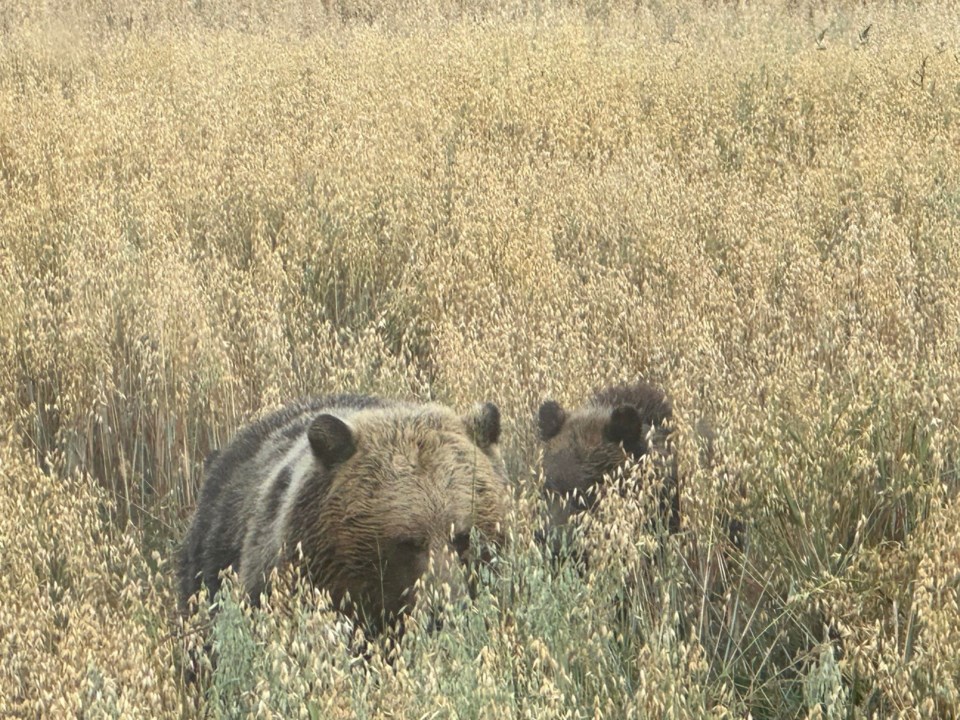Concerned Pemberton locals and bear experts are calling for the creation of a designated Grizzly Bear Management Specialist position in the Sea to Sky corridor. The call comes as families in Pemberton Meadows say they are living in fear of a nearby grizzly and her cubs, after children in the area have reportedly come face to face with the bear while playing outside.
At a Squamish-Lillooet Regional District (SLRD) board meeting on Nov. 22, the board considered a small batch of letters addressed to provincial environment minister George Heyman, eventually deciding to refer the concerns to staff and liaise with the RCMP about public safety issues and future steps.
In the letters, two Pemberton residents noted an “evolving societal view” towards grizzly bears in B.C. has led to positive co-existence efforts, and applauded the work non-governmental organizations have done to educate and help locals.
But the residents of Whistler, Pemberton, Birken and D’Arcy have had their daily lives altered by the presence of grizzly bears over the past three years, they said.
“While Sea to Sky residents are generally (but not unanimously) in favour of grizzly bear recovery, we must point out that co-existence is costly, nerve-wracking and potentially dangerous,” the letters read. “We should not be expected to shoulder the full burdens of co-existence, which include crop losses, livestock degredations and the potential threat to our family’s safety.”
The locals insisted that if the province wants to see grizzly bears on the landscape, it should do more to help people affected by co-existence stumbling blocks.
Area C Director Russell Mack said the province needs to take action during the bears’ hibernation period. He pointed out a grizzly bear was frequenting his backyard at the time of the meeting.
“Something serious is going to happen,” he said. “These are apex predators. They are not pets as people are making them out to be. Somebody is going to walk into one at the wrong time.”
While local conservation officers have done their best to deal with ongoing issues, they are experiencing serious staff shortages and have to cover a “huge area of responsibility,” the letter-writers noted, adding the province’s approach appears to lack direction.
“The response [from COS] has also been inconsistent—which, in our view, may reflect a lack of clear provincial objectives for grizzly bear recovery/co-existence,” they said. “We require a proactive approach that supports those navigating the complexities of coexistence, rather than reacting to situations as they arise.”
The residents asked the province to hire a dedicated grizzly bear specialist to start in the corridor in the spring of 2024.
A letter from grizzly bear experts Lana M. Ciarniello, Bruce McLellan and Michelle McLellan noted some bears are spending “considerable time” in areas where people live, including Pemberton Meadows, Whistler, Birken and D’Arcy.
“The number of grizzly bears, in some, but certainly not all, populations in the south Coastal Mountains of British Columbia are increasing,” they wrote. “In particular, populations to the north of Anderson Lake, northwest of Pemberton, and west of Whistler have been growing at about three per cent a year for the past few decades.”
The experts noted the populations south of Anderson Lake and south east of Pemberton and Whistler are “very small, highly inbred, and barely hanging on.”
“These bears are needed to gradually and naturally augment the adjacent small and struggling populations,” stressed the scientists. “But people living in the valleys are not accustomed to having grizzly bears living amongst them; many are highly concerned and need help.”
The group added the Sea to Sky corridor can learn from other parts of the world that have dealt with similar problems, noting people have learned how to coexist with grizzly bears in Rocky Mountain National Park, northern Montana and around Yellowstone National Park.
“In these areas, experts on localized bear management are employed to educate and help people secure or remove attractants, aversively condition bears (rubber or bean-bag bullets, trained dogs, or bear capture) that are pushing boundaries, and remove, by capturing or euthanizing, bears that have crossed the line of human safety,” they wrote.
Given the recent issues surrounding grizzlies in the corridor, the recovery is now “clearly at the stage when at least one dedicated, on-site bear management expert is needed,” they concluded.




